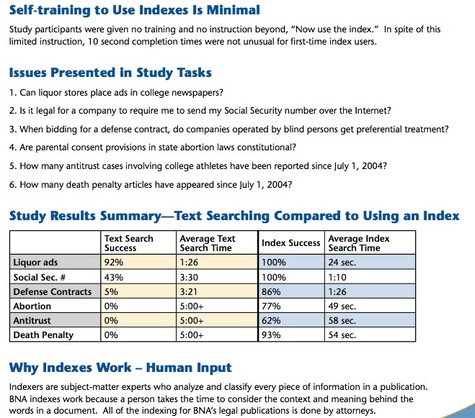For the ASI conference, David Ream presented an update of what the ASI Digital Trends Task Force unit have been up to for the past year (or three)- completing a coding language of the structural components of an index that software developers can adapt for EPUB platforms. At least, that is how I understood his presentation. Early on in it, Mr. Ream threw up this image (above) in the powerpoint (for about 3 seconds) and when I saw it, it kind of blew my mind a bit. I asked him to go back to it during his talk, and I want to show it again here, in a screen capture. It's a chart of results drawn from this Levtech resource http://www.levtechinc.com/pdf/Using%20BNA%20Indexes%20study.pdf. It illustrates time taken to access information through use of an index or keyword search. The INDEX clearly wins!
As a researcher, when I have come upon a beautiful index, it elicits pure emotion. I know this sounds weird to anyone who is not a researcher or an indexer - but pure delight and admiration. Wow. A good index is SO useful!! The beautiful ones are distinct I think, and somewhat rare. But any functional index is waaay better than none! The chart shows clearly how quickly an index can make information accessible, and I was actually a bit thrilled to see it, because it becomes exasperating trying to explain to people the difference between a keyword search and an index (we've all been there too many times). It illustrates the time taken doing it both ways, as you might say. Maybe I will whip it out the next time someone asks me! Feel free to add it to your websites!
Another thing that turned me on (as an Indexing person) was a 'User case scenario 2' that the Task Force had posited for how to locate the web index or EPUB index on screen. I loved the idea of having it pop-up as you hover over a locator, to indicate other related entries. Does that make sense to anyone else? I see it as a kind of transparent overlay- you can see through it, to what you are reading in the ebook. It appears and disappears as needed. It could also pop up as a sidebar, or as an editing bubble like on Word.
Anyway, my preferences aside, the work they have done is amazing, and translates into something really useful. I am comparing it to the very little I know through watching a webinar presented by the ASI last October: Converting Legacy Print Book Indexes for Use in ebooks. It seems to me that the DTTF folks have gone way beyond what was being discussed and wrangled through only 6 months ago. Someone said it was like the era when no one knew whether the common language of video would be VHS or Beta. It was a kind of relief to me to see how far they had come in working out a code for coders. These are the thoughts of an indexing naif. I'd be happy to learn others' perspectives.
As a researcher, when I have come upon a beautiful index, it elicits pure emotion. I know this sounds weird to anyone who is not a researcher or an indexer - but pure delight and admiration. Wow. A good index is SO useful!! The beautiful ones are distinct I think, and somewhat rare. But any functional index is waaay better than none! The chart shows clearly how quickly an index can make information accessible, and I was actually a bit thrilled to see it, because it becomes exasperating trying to explain to people the difference between a keyword search and an index (we've all been there too many times). It illustrates the time taken doing it both ways, as you might say. Maybe I will whip it out the next time someone asks me! Feel free to add it to your websites!
Another thing that turned me on (as an Indexing person) was a 'User case scenario 2' that the Task Force had posited for how to locate the web index or EPUB index on screen. I loved the idea of having it pop-up as you hover over a locator, to indicate other related entries. Does that make sense to anyone else? I see it as a kind of transparent overlay- you can see through it, to what you are reading in the ebook. It appears and disappears as needed. It could also pop up as a sidebar, or as an editing bubble like on Word.
Anyway, my preferences aside, the work they have done is amazing, and translates into something really useful. I am comparing it to the very little I know through watching a webinar presented by the ASI last October: Converting Legacy Print Book Indexes for Use in ebooks. It seems to me that the DTTF folks have gone way beyond what was being discussed and wrangled through only 6 months ago. Someone said it was like the era when no one knew whether the common language of video would be VHS or Beta. It was a kind of relief to me to see how far they had come in working out a code for coders. These are the thoughts of an indexing naif. I'd be happy to learn others' perspectives.


 RSS Feed
RSS Feed